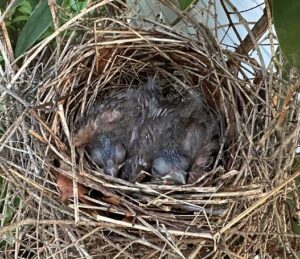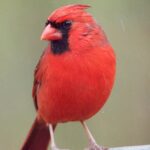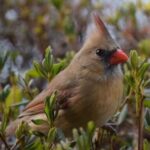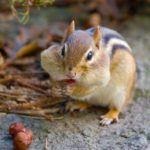Hello, fellow lovers of all things green. A few of you asked for updates on the late-season Cardinal’s nest mentioned last week. Debbie wrote, “I’m so excited about your cardinals. Although they don’t look so pretty right now. We all know how they will turn out in time!”

Baby Cardinals – August 18, 2025
It’s true; like most bird hatchlings, their bulging eyes make them look alien. My heart sank on Thursday morning when I found the nest vacant and a bit disheveled. Did a predator snag the hatchlings? I heard the barred owl calling in the night. Surely the little guys couldn’t have fledged so quickly. But my curiosity about the cardinals brings wisdom.
My heavy heart turned around.
As I gazed at the nest, I listened to the gentle chirps of an adult cardinal nearby. The same chirps they sang during the hatchling stage to coordinate their care and feeding with their mate. Yet, I looked several times and couldn’t spot either parent. Jolee helped investigate below the nest during our first call over the footbridge—no babies to be found.
I felt sad wanting a happy ending for the young family—we all do.
It wasn’t until this morning’s curiosity that I learned baby cardinals fledge 9 to 10 days after hatching. By comparison, the American Robin fledge their nest in 13 days. So perhaps it was a happy ending for the Cardinals’ brood after all. And the soft, subtle chirps that sounded like “took” were the ongoing coordination of communication between parents taking care of their young outside of the nest.
For the first week or so after fledging, the young spend time on the ground or low branches to hone their flying skills. The male Cardinal continues to feed and care for the young birds for several weeks, allowing the female to build a new nest and incubate a new clutch of eggs. The babies become fully independent between 25 and 56 days old.

Photos by Mike Niven
Male and female cardinals look similar for a few months.
Cardinal fledglings have fluffy, buff-brown plumage, sometimes with reddish streaks. The male and female look similar for a few months. It’s not until they are juveniles, at three or four months old, that the males’ feathers will become mottled with red as new feathers emerge. The female’s feathers grow into mottled sandy-brown colors.
They both have a significant molt in the fall, replacing most of their juvenile feathers in time for winter. They’ll have their full adult color at one year old. The male is bright red, and the more subtle, camouflaged female has light brownish-gold feathers with red accents.

Photo by Mike Niven
Winter starts on December 21, less than four months away. Will the baby birds have their adult feathers in time? I take comfort knowing Mother Nature knows what she is doing.
Northern Cardinals (Cardinalis cardinalis) mate for life. Though primarily seed, fruits, and “green” eaters such as grasses and tree buds, insects comprise thirty percent of a cardinal’s diet, including garden pests. Beyond that, their vibrant colors decorate our world all year long, as they do not usually migrate. You can keep them in your yard in winter by providing sunflower seeds and a water source. There are nifty water heaters you can buy for your birdbath to keep it from freezing.
Other Musings about Cardinal Encounters
Speaking of cardinals, I came across a few observations that I jotted down in my morning pages, inspired by Julia Cameron’s creative exercise described in her classic book, The Artist’s Way. The first reflection was from the Fall of 2021.
A female cardinal was cautiously looking at me through the window above the kitchen sink as I witnessed her grab one of the viburnum berries and enjoy its sweetness. The next day, a chipmunk climbed the tree for its portion. I wonder if it’s the same little fellow that’s destroying the roots of the chrysanthemums in the rock garden.
We can’t blame the cute little critter. I have to say, though, Jolee is angry at their occupation and caught a few with the prowness of a cat. Not to kill, but there have been injuries. My instinct was to shoo the little chipper from out of the shrub—a ridiculous remedy given how many live amongst the rocks. Besides, there’s plenty of bounty to share with our furry and feathered friends.
The other musing was midsummer that same year.
A male cardinal has been visiting frequently, and I’ve seen the female from time to time. I hoped they were nesting in the viburnum outside of the kitchen window. I saw a nest, but it resembled a light gray, upside-down umbrella. Upon closer inspection, it turned out to be a wasp nest, not a cardinal nest.
Isn’t it interesting how we marvel over birds’ nests and not wasp nests?
How my curiosity about the cardinals brings wisdom
There’s wisdom in the experience of a heavy heart when I saw the empty nest, then digging in to learn that there was likely a successful fledging after all. I heard the sweet chirps of an adult cardinal “toot …toot” again this morning. Last week, we shared how Nature Teaches Endings Bring Beginnings. May I add that Nature also teaches that things aren’t always as they seem.

Garden Dilemmas? AskMaryStone@gmail.com and your favorite Podcast App.
Enjoy more of the story in The Garden Dilemma’s Podcast:
A bit about paper wasps:
I’ll admit, I considered destroying the developing home for the paper wasps, as it was above the stone patio where we dine. However, I learned that the abode was a Northern Paper Wasp nest (Polistes fuscatus), which is unlikely to sting unless disturbed or threatened. And they are predators of undesirable garden and crop pests, including cabbage worms, tomato hornworms, corn earworms, tent caterpillars, and grubs. Plus, they are pollinators, feeding on nectar and transferring pollen from plant to plant, though not as efficiently as bees. We can’t hold it against them that they don’t have hairy legs and fuzzy bodies that transport pollen more readily. While paper wasps are attracted to food and drinks, we can opt to entertain inside.
Related Stories:
Nature Teaches Endings Bring Beginnings – Blog Post
Ep 218. Nature Teaches Endings Bring Beginnings -Podcast Episode
Mike Niven, a high school buddy of mine, shared the adult cardinal photos above. Enjoy these stories featuring Mike:




Another very enjoyable podcast. I sure enjoy Sunday mornings with your messages. Glad the cardinals had a happy ending. I choose to believe they are flitting around with mom and dad teaching them how to be birds. Have a great week.
Thank you, Ken, for being my most faithful reader and supporter :^). You are the kindest, Mary